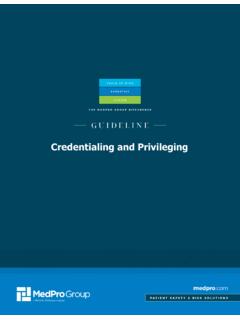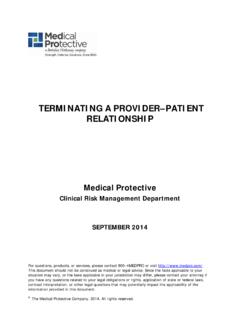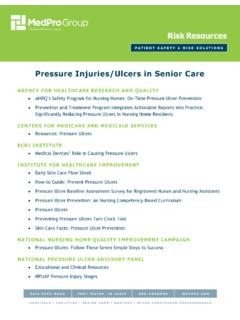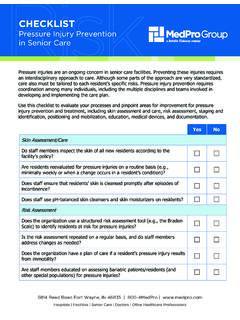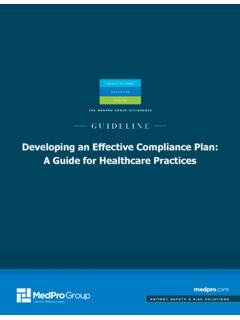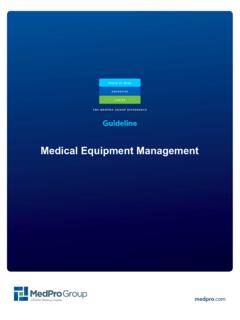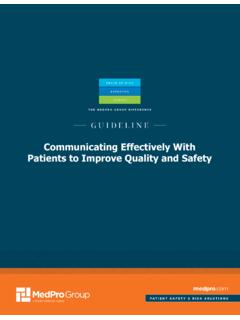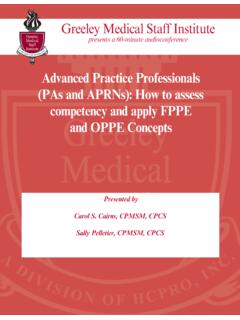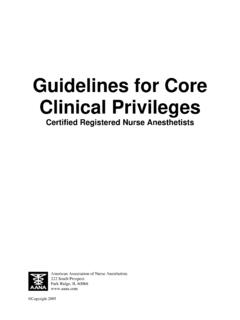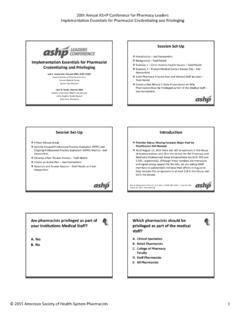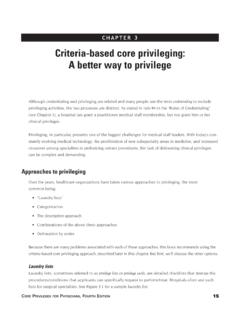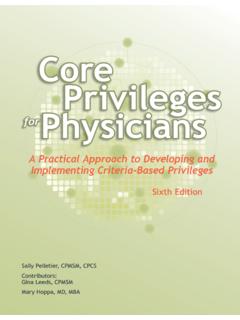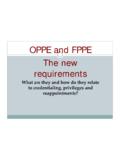Transcription of CREDENTIALING AND PRIVILEGING - Medical Protective
1 CREDENTIALING AND PRIVILEGING Medical Protective Clinical Risk Management Department MARCH 2014 For questions, products, or services, please contact 800 4 MEDPRO or visit This document should not be construed as Medical or legal advice. Since the facts applicable to your situation may vary, or the laws applicable in your jurisdiction may differ, please contact your attorney if you have any questions related to your legal obligations or rights, application of state or federal laws, contract interpretation, or other legal questions that may potentially impact the applicability of the information provided in this document. The Medical Protective Company.
2 2014. All rights reserved. CONTENTS INTRODUCTION .. 3 OBJECTIVES .. 3 BACKGROUND .. 4 CREDENTIALING Foundations .. 4 THE CREDENTIALING /RECREDENTIALING PROCESS .. 4 Structure .. 4 Application Process .. 5 Preapplication .. 5 Application .. 5 Applicant Identification .. 6 Application Processing .. 7 Special CREDENTIALING Considerations .. 7 Telemedicine Providers .. 7 Applicants Who Have Collaborative or Supervisory Agreements .. 7 CREDENTIALING RED FLAGS .. 8 PRIVILEGING REQUIREMENTS (INITIAL AND ONGOING) .. 8 PROFESSIONAL PRACTICE EVALUATION MONITORING .. 9 Focused Professional Practice Evaluation .. 9 Ongoing Practice Performance Evaluation .. 9 Performance Monitoring Methods.
3 10 CONCLUSION .. 10 RESOURCES ON CREDENTIALING .. 11 Guideline: CREDENTIALING and PRIVILEGING 3 INTRODUCTION The Department of Health and Human Services definition for CREDENTIALING is the process of assessing and confirming the qualifications of a licensed or certified health care practitioner. 1 CREDENTIALING is an essential process that healthcare organizations and practices must perform to ensure those providing services are qualified to do so. The process has become more complicated over time due to the expansion of providers scopes of service, the requirements of third-party payers ( , the government and private health insurance plans), and organizational standards (accrediting bodies).
4 The companion piece to CREDENTIALING is PRIVILEGING , which is the process of authorizing a licensed or certified healthcare practitioner s specific scope of patient care services. PRIVILEGING is performed in conjunction with an evaluation of an individual s clinical qualifications and/or performance. In the past, CREDENTIALING and PRIVILEGING were mainly associated with hospitals. Now, these processes are required at healthcare facilities, ambulatory surgical centers, and long-term care organizations. This guideline will examine some of the important aspects of the CREDENTIALING and PRIVILEGING processes. OBJECTIVES The purpose of this guideline is to: Discuss organizational responsibility for, and the importance of, CREDENTIALING and PRIVILEGING ; Describe the various elements of the CREDENTIALING and PRIVILEGING processes and how they apply within healthcare organizations; Review special considerations for CREDENTIALING and PRIVILEGING , as well as potential red flags associated with these processes; Discuss requirements for initial and ongoing PRIVILEGING ; and Examine performance monitoring criteria and methods.
5 1 Health Resources and Services Administration. (2001, 2006). CREDENTIALING & PRIVILEGING of health center practitioners. Policy Information Notice 2001-16. Retrieved from Guideline: CREDENTIALING and PRIVILEGING 4 BACKGROUND CREDENTIALING Foundations Healthcare organizations are charged with providing the proper environment and adequate resources to support safe patient care. Paramount to this charge is having Medical staff bylaws that define minimum CREDENTIALING and PRIVILEGING requirements for validating the competency of providers. Medical staff bylaws should provide the framework for administrative procedures and processes to ensure practitioners provide safe and competent care.
6 For CREDENTIALING and PRIVILEGING , bylaws should specifically address: The preapplication process and grounds for denying applications; Reapplication requirements and grounds for denying reapplications; Incomplete applications; Appointments for less than 2 years; Limitations and rights for practitioners granted temporary, emergency, disaster, or locum tenens privileges; and The effect of application completion ( , by completing the application, the candidate agrees to all of the conditions and expectations listed). When developing the written policies that will govern CREDENTIALING and PRIVILEGING , healthcare organizations should consult their legal counsel to ensure that all policies are consistent with state laws and professional requirements.
7 Further, organizations should ensure a fair process is in place to review grievances with any of the THE CREDENTIALING /RECREDENTIALING PROCESS Structure The CREDENTIALING process for healthcare providers should be completed prior to an individual being allowed to provide patient care services. Additionally, the healthcare organization should perform the initial granting of privileges in a timely manner, with the ultimate approval authority vested in the governing board. Some governing boards may choose to use an approved credentials verification organization (CVO) to validate provider qualifications. Organizations may want to work with their CVOs to outline an expedited process for gathering and validating information in the event of an emergency.
8 2 It is suggested that organizations review governing processes every 2 years. Legal counsel should review updates or changes before the approval process is activated through the Medical staff and the organization. The approval of the governing body is always the final step. Guideline: CREDENTIALING and PRIVILEGING 5 Recredentialing and the revision or renewal of a provider s privileges should occur at least every 2 years. Similar to the initial granting of privileges, approval of subsequent privileges is vested in the governing board, which may review recommendations or delegate the responsibility.
9 The responsible party will complete the PRIVILEGING process according to approved policies and procedures. Application Process Healthcare organizations typically use a two-step application process. The first step is completion of a preapplication to ensure that providers meet basic qualifications for membership at the organization (as outlined in the Medical staff bylaws). Preapplication The preapplication process saves time and resources by identifying candidates who do not meet the minimum requirements for staff membership prior to the full application process. Preapplication documents should clearly state that they are not applications. Preapplication questions minimally address:3 Disciplinary action or sanctions by licensing boards, payers, or professional organizations; Unrestricted licensure; Criminal history; Board certification, if required; Clinical specialty and any specialty-related requirements; and Health status.
10 The preapplication may also require the candidate to submit a curriculum vitae (CV) with his or her preapplication responses. Application If the applicant meets the minimum requirements, the organization may send him or her a full application. Although some states have standardized CREDENTIALING applications, all applications should include the effect of completion of the application. 3 Preapplications and applications should comply with the Americans with Disabilities Act (ADA). Consult with your legal counsel if you have questions about ADA compliance. Guideline: CREDENTIALING and PRIVILEGING 6 Provisions in the application typically require the practitioner to:4 Agree to provide continuous care to his or her patients.
